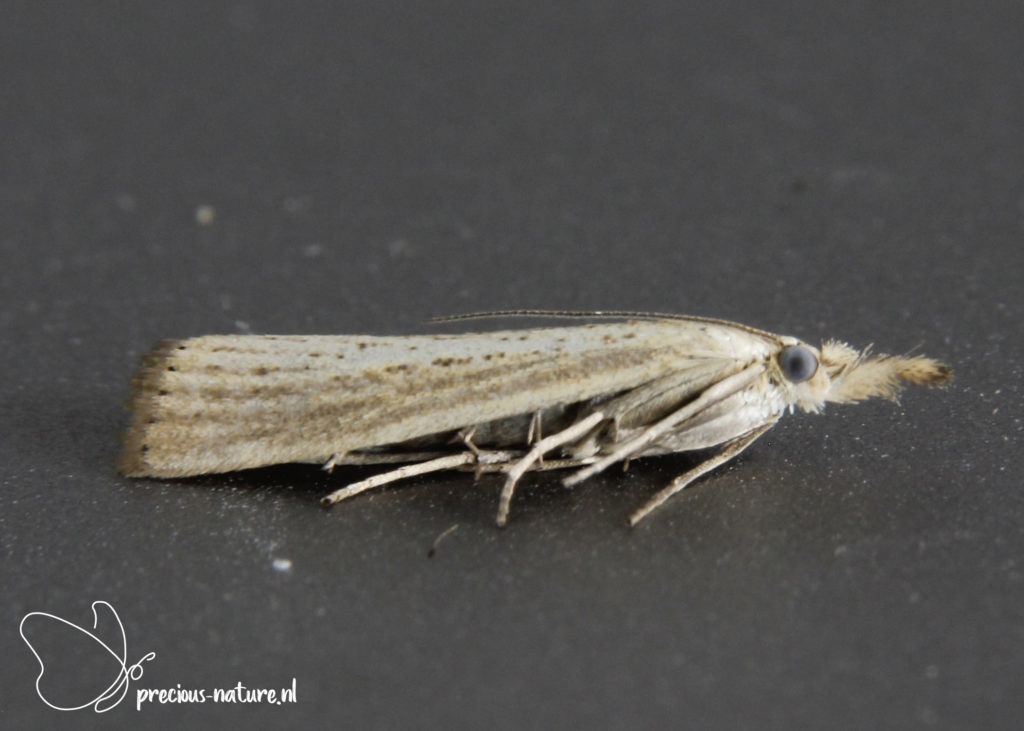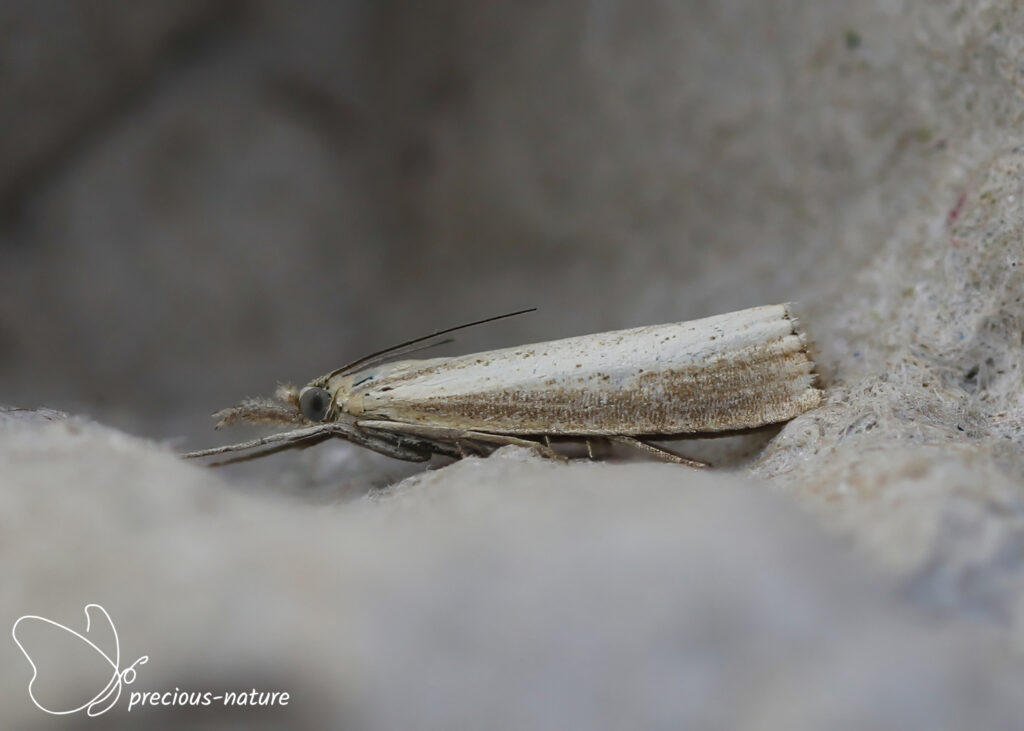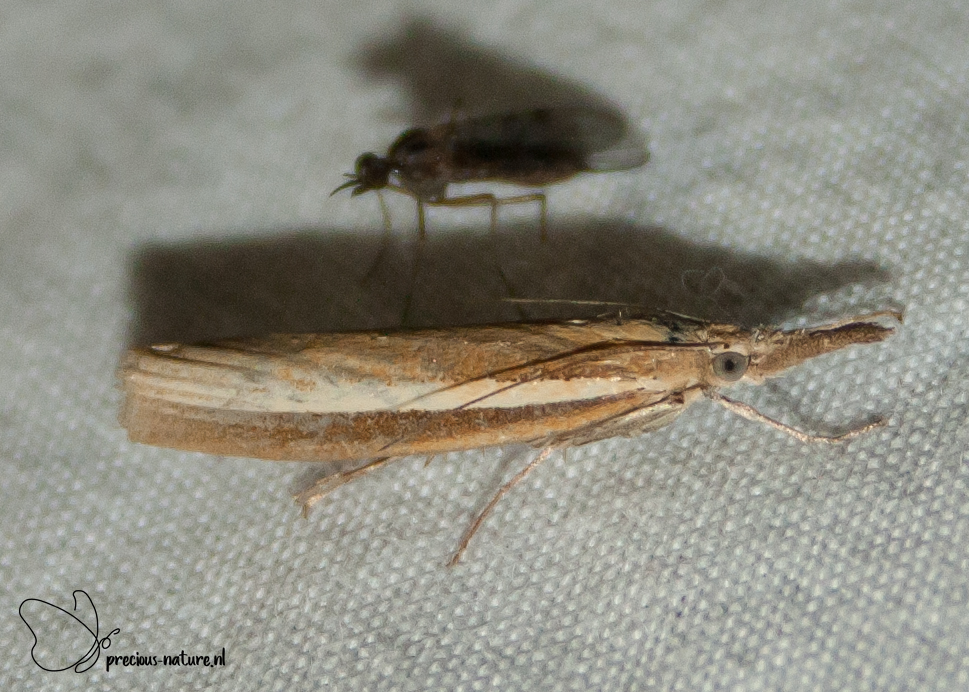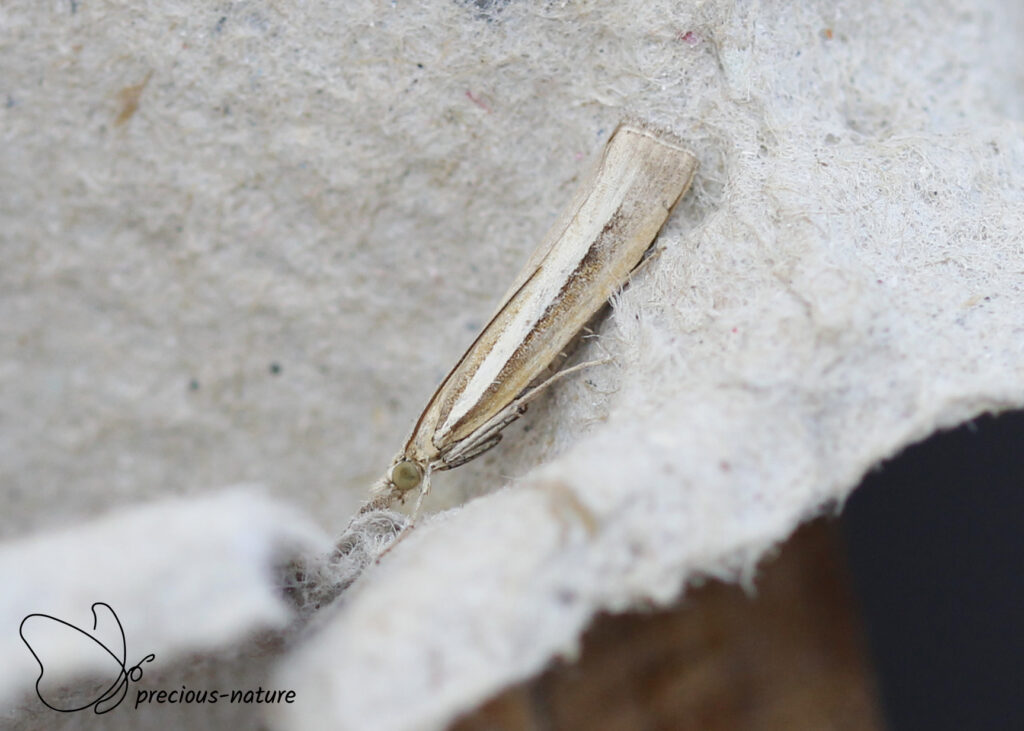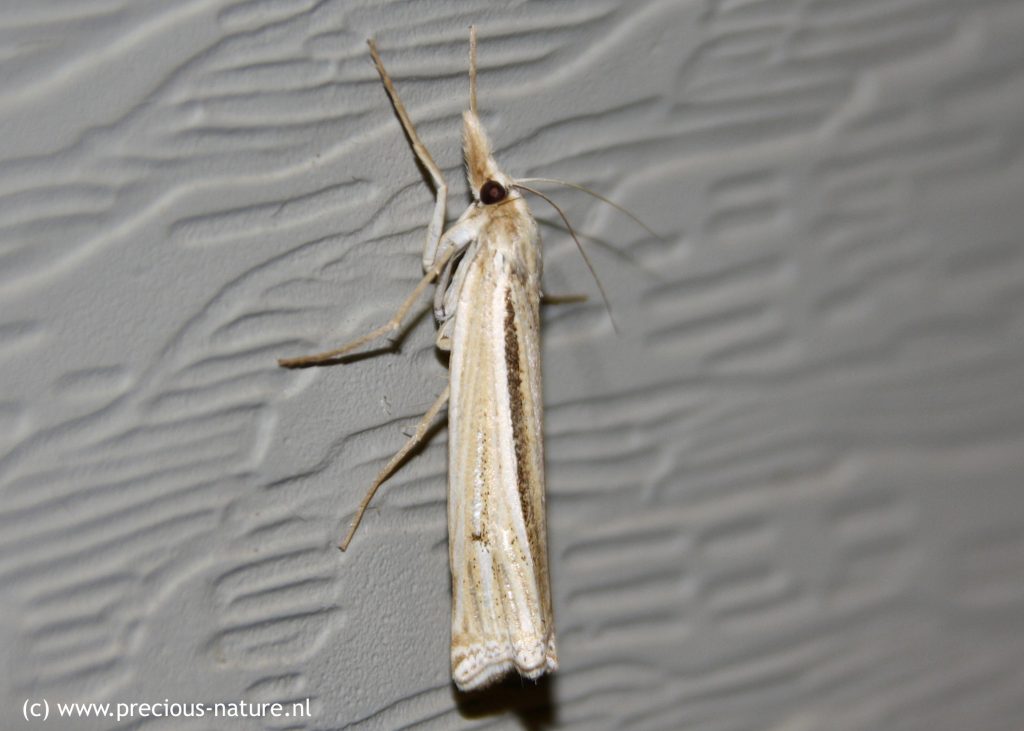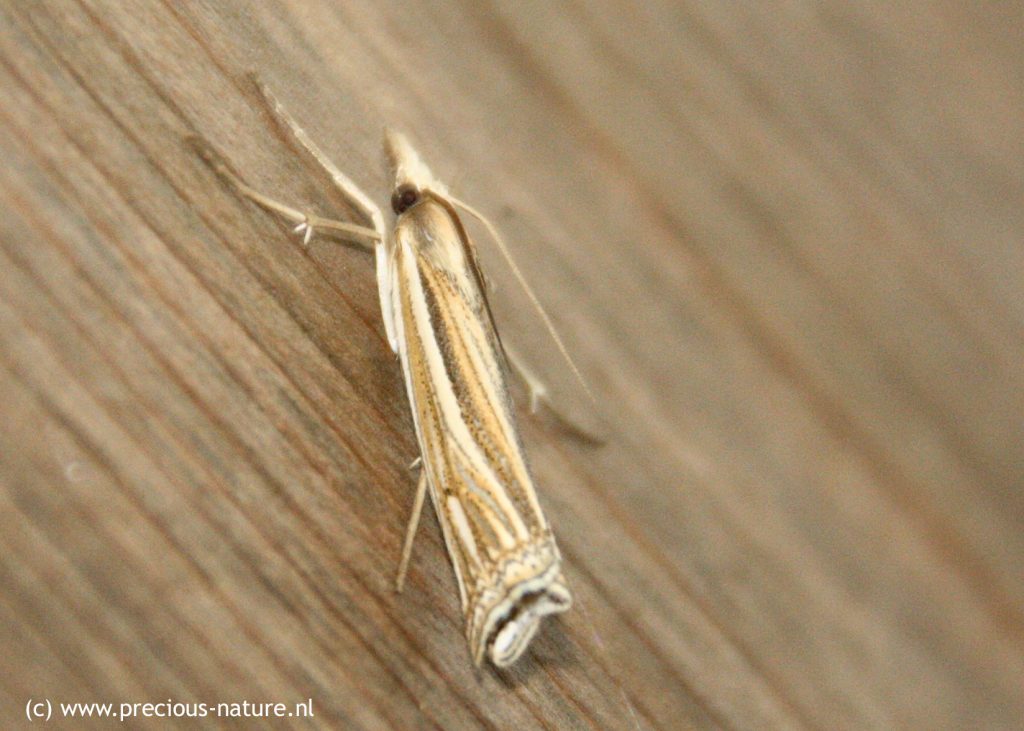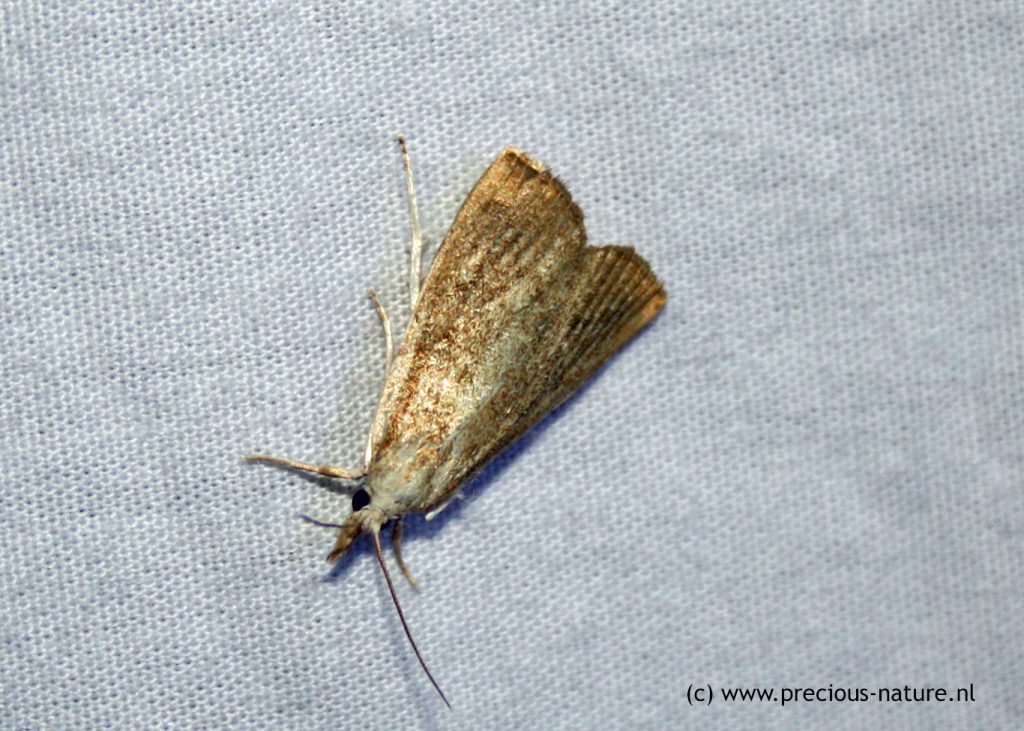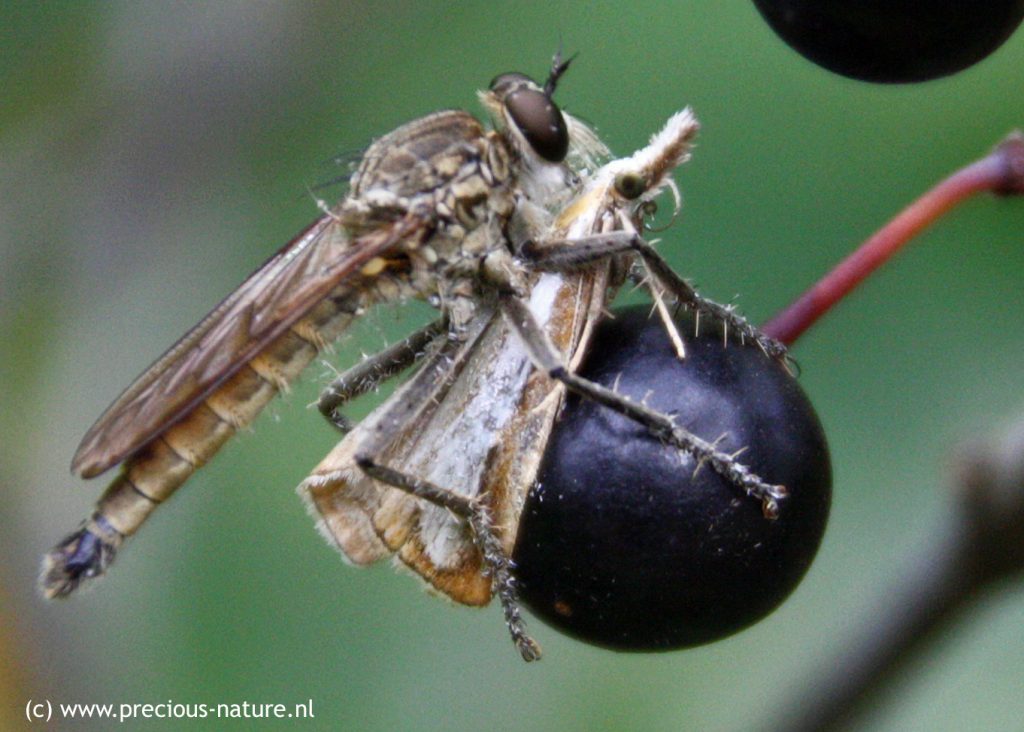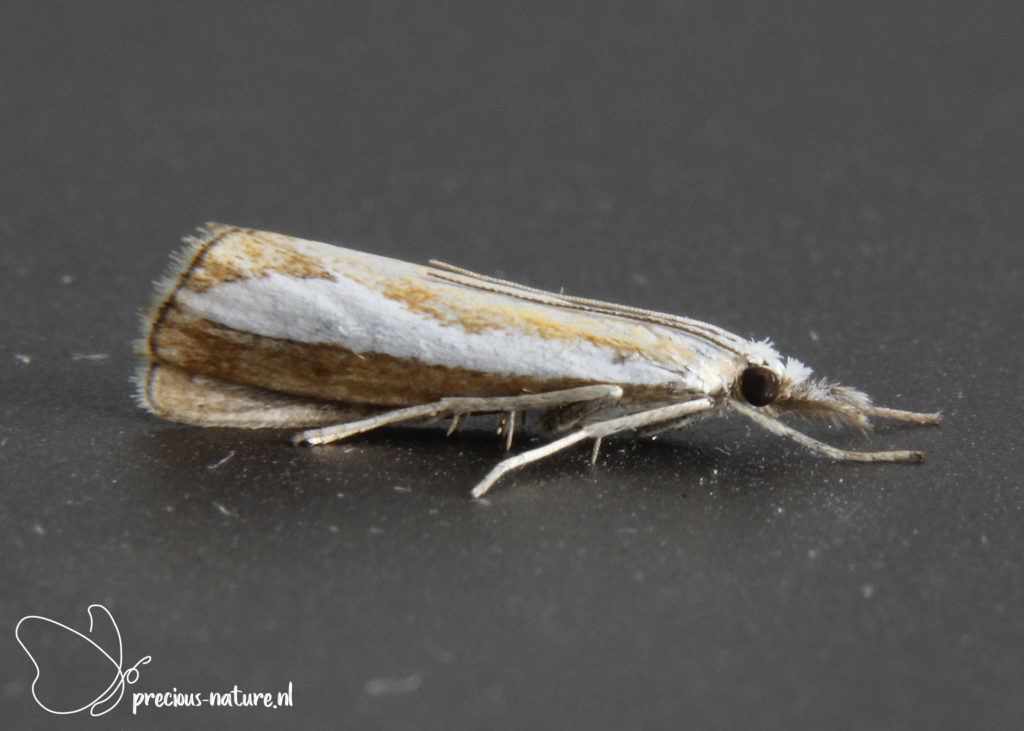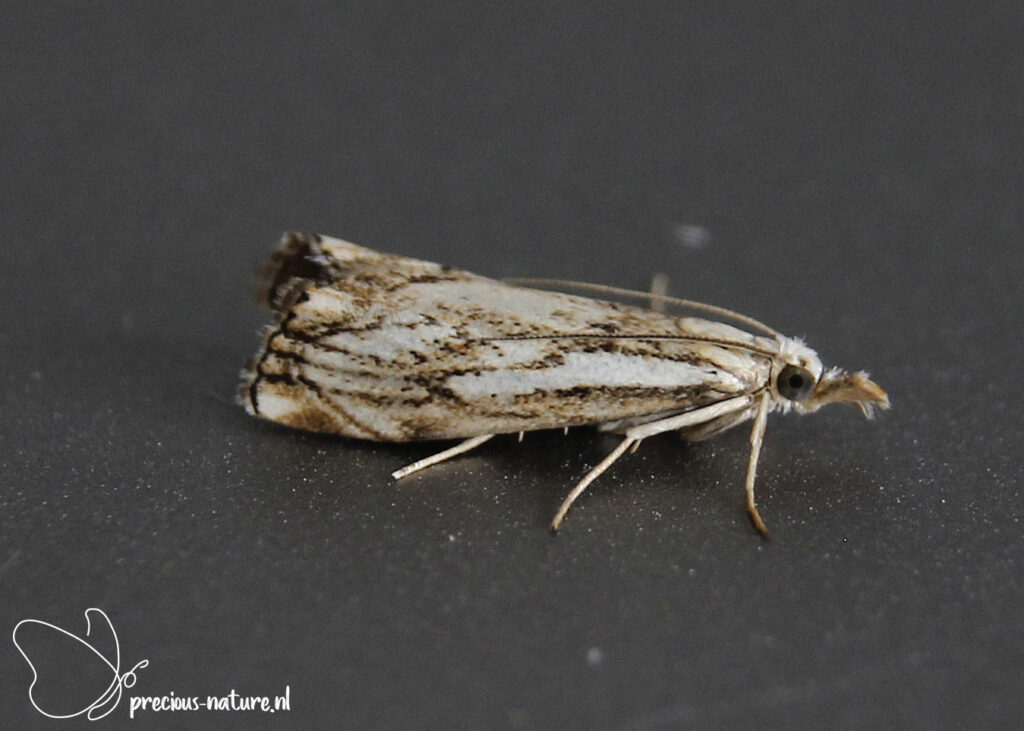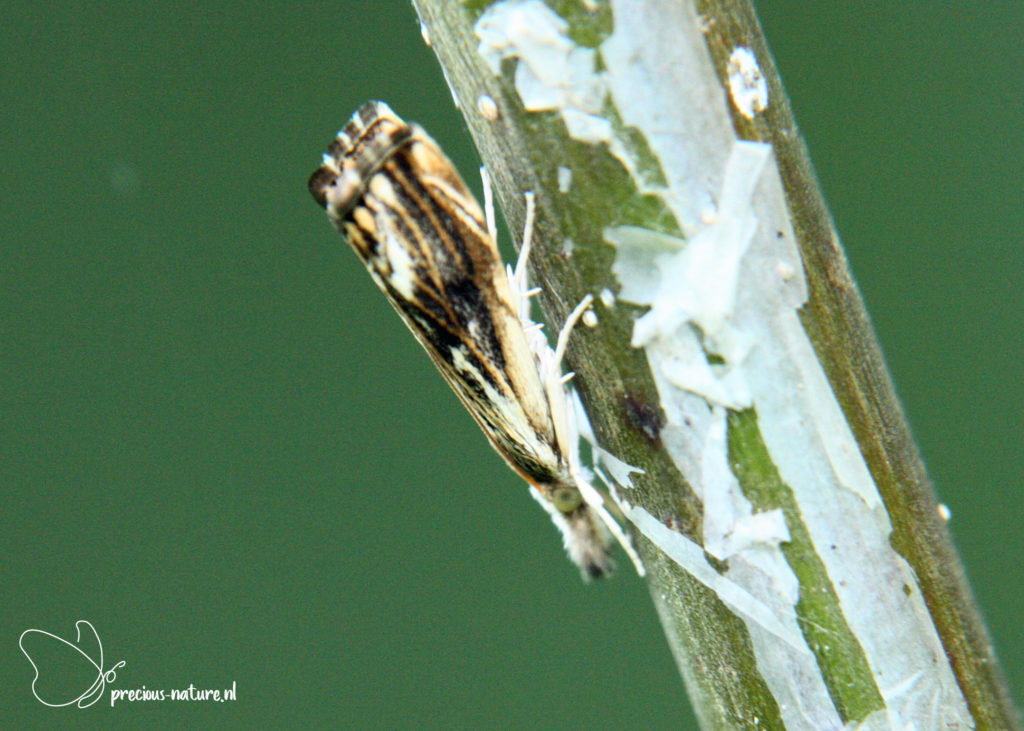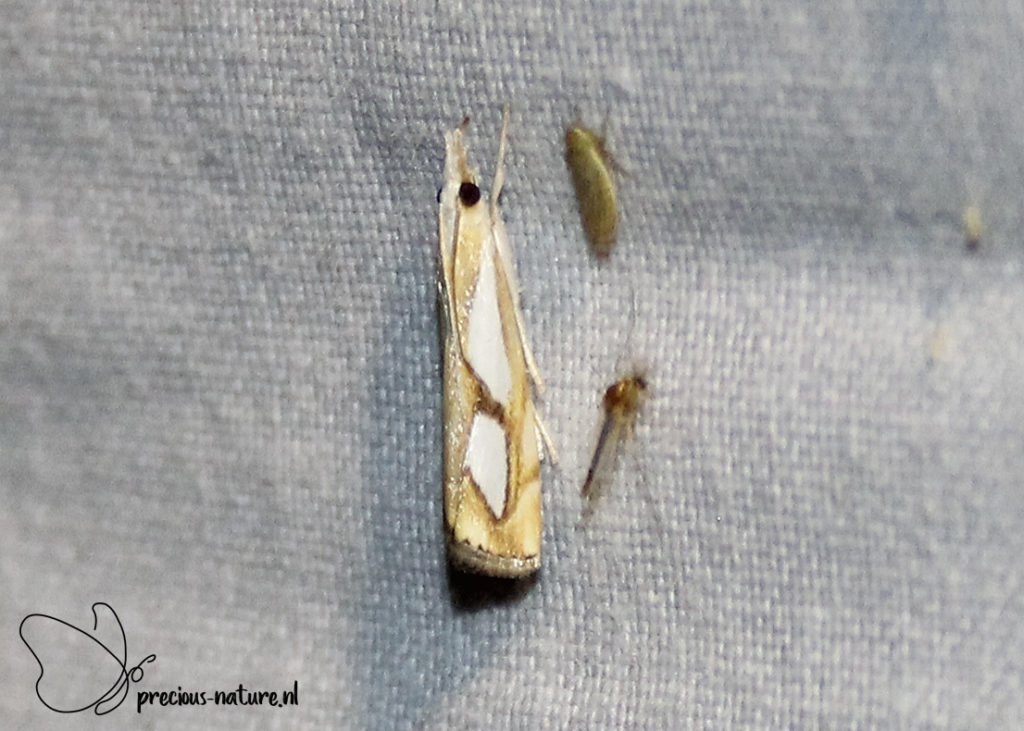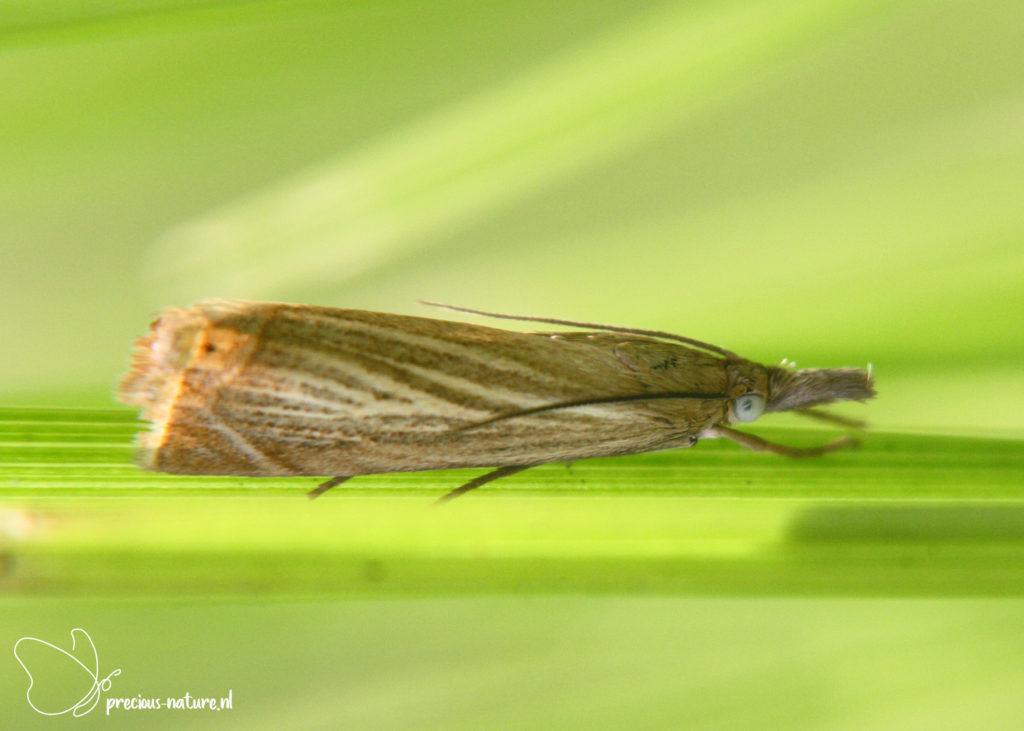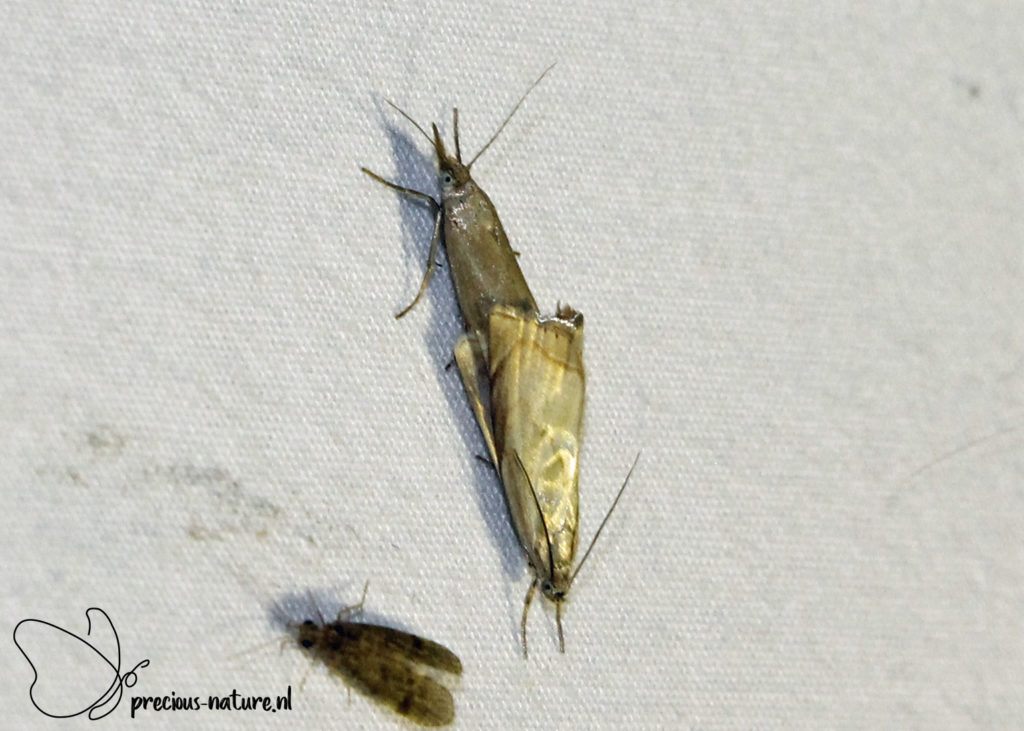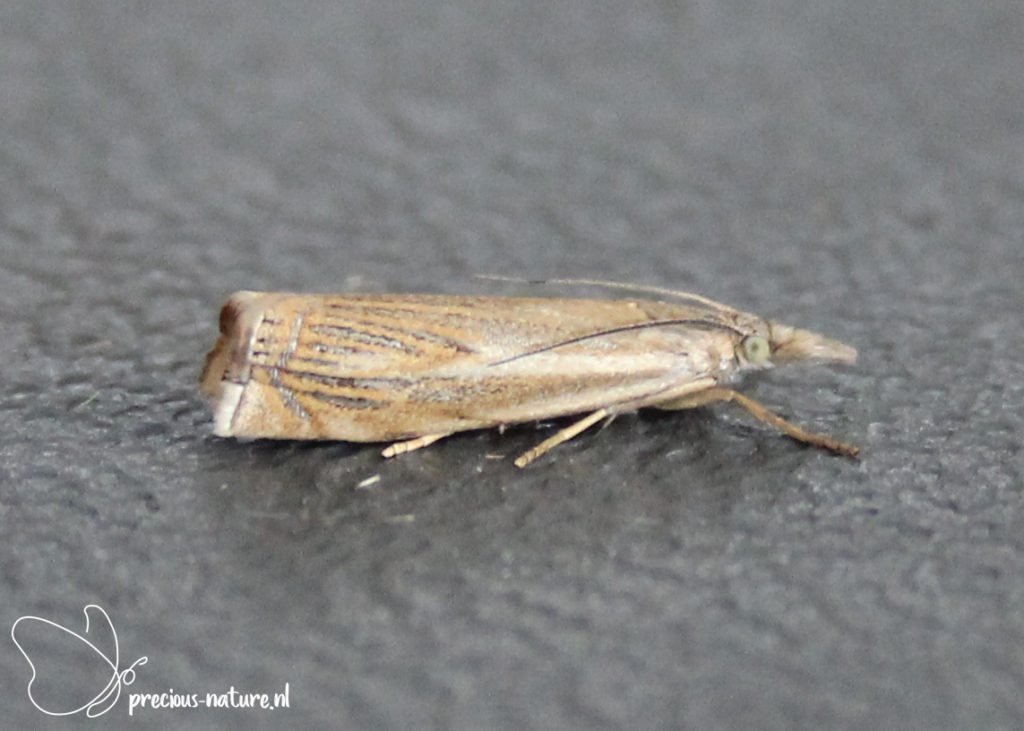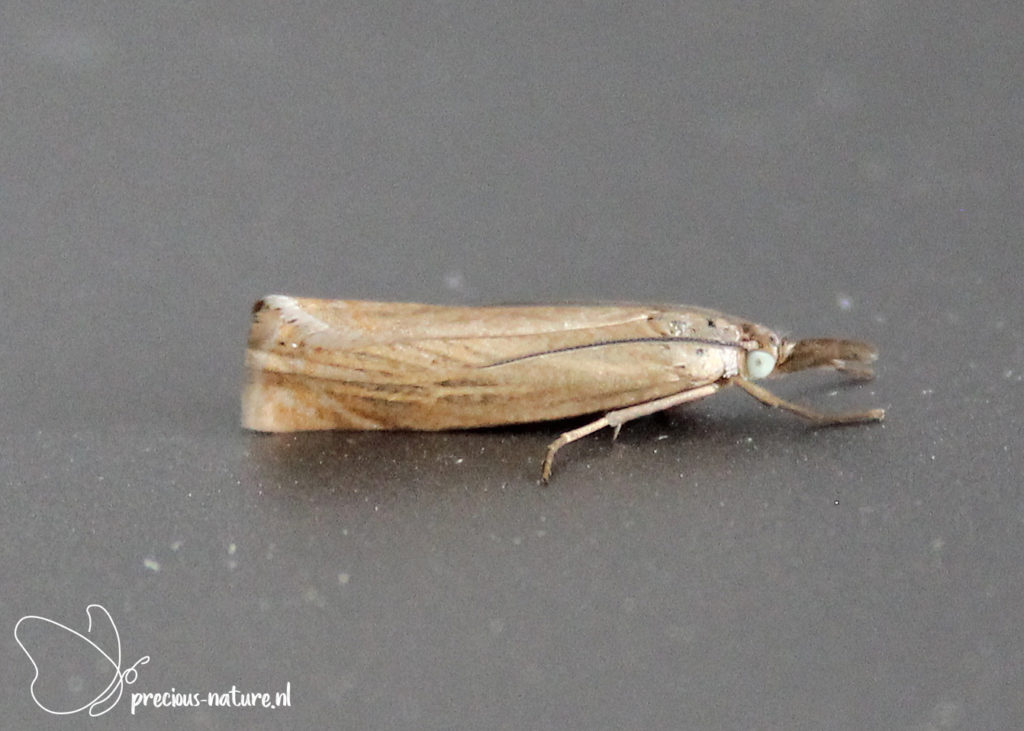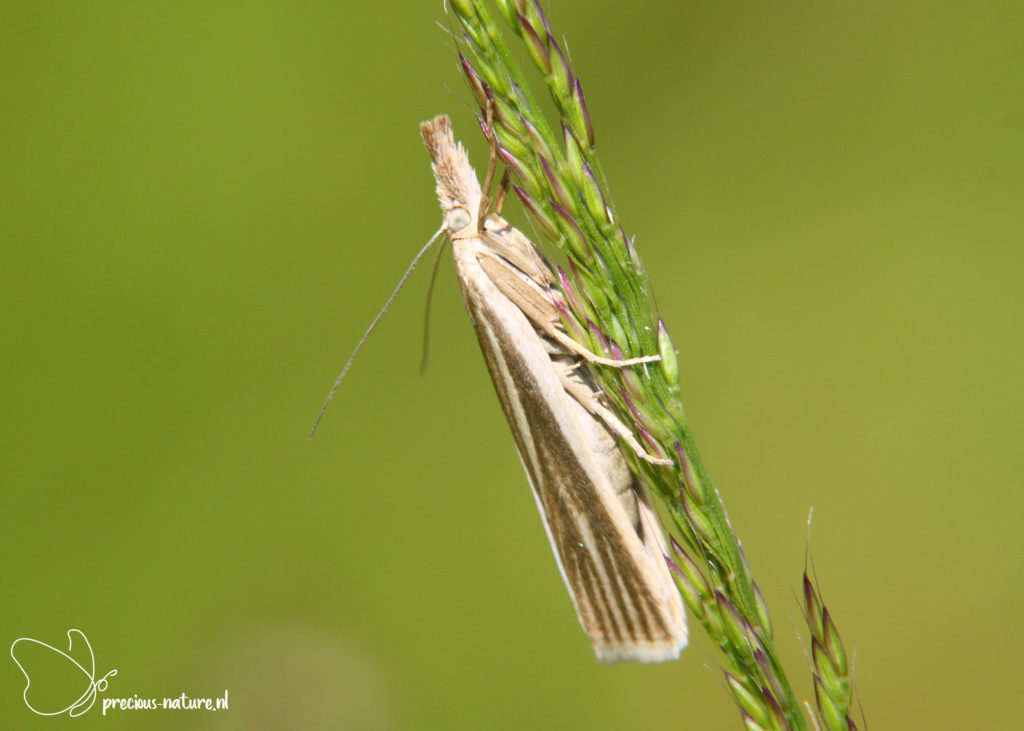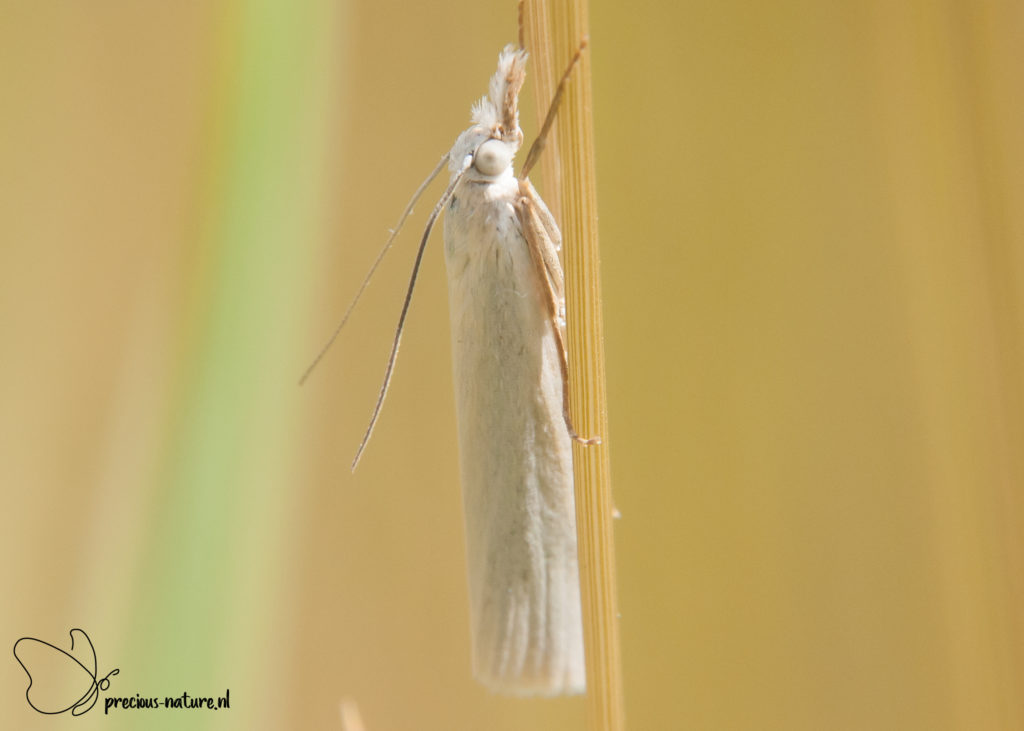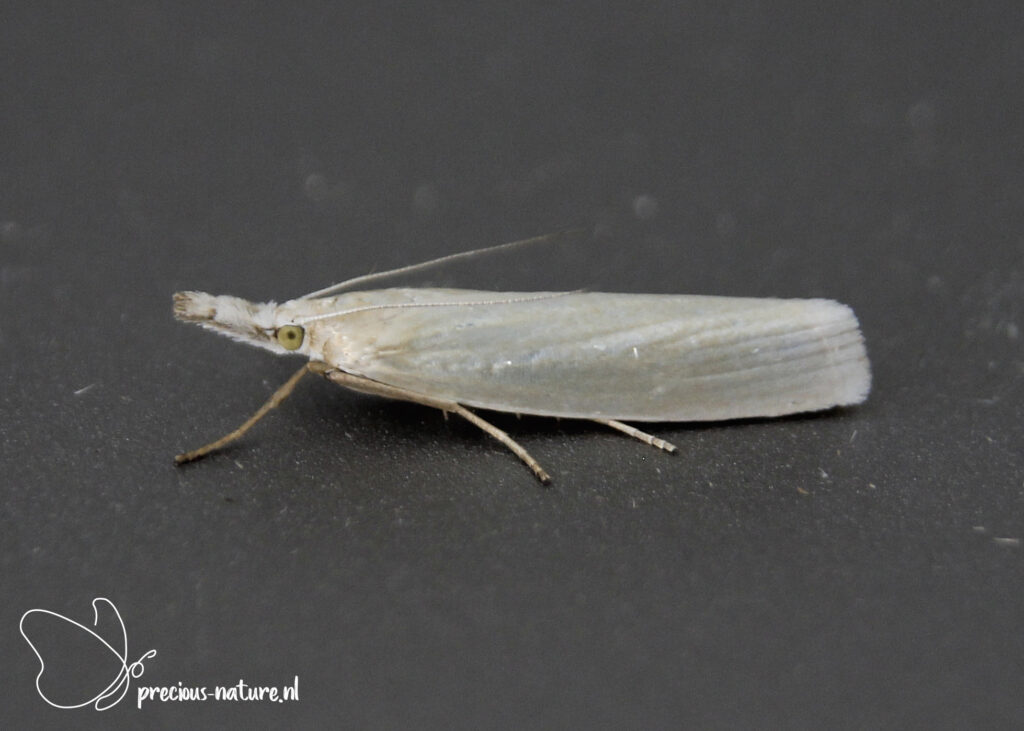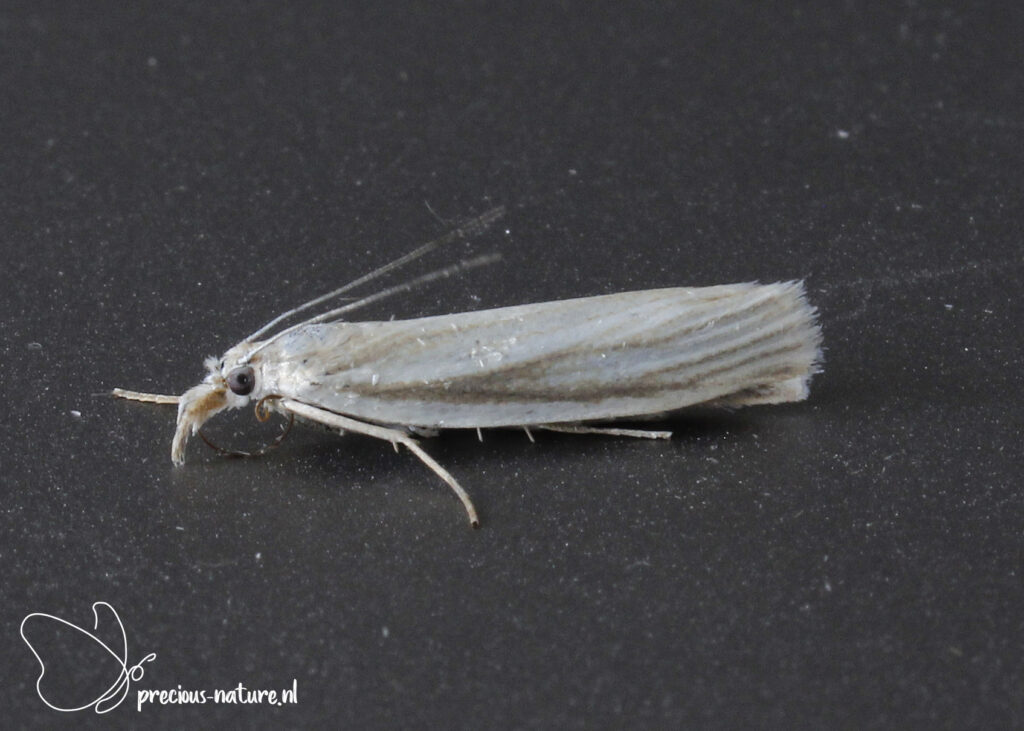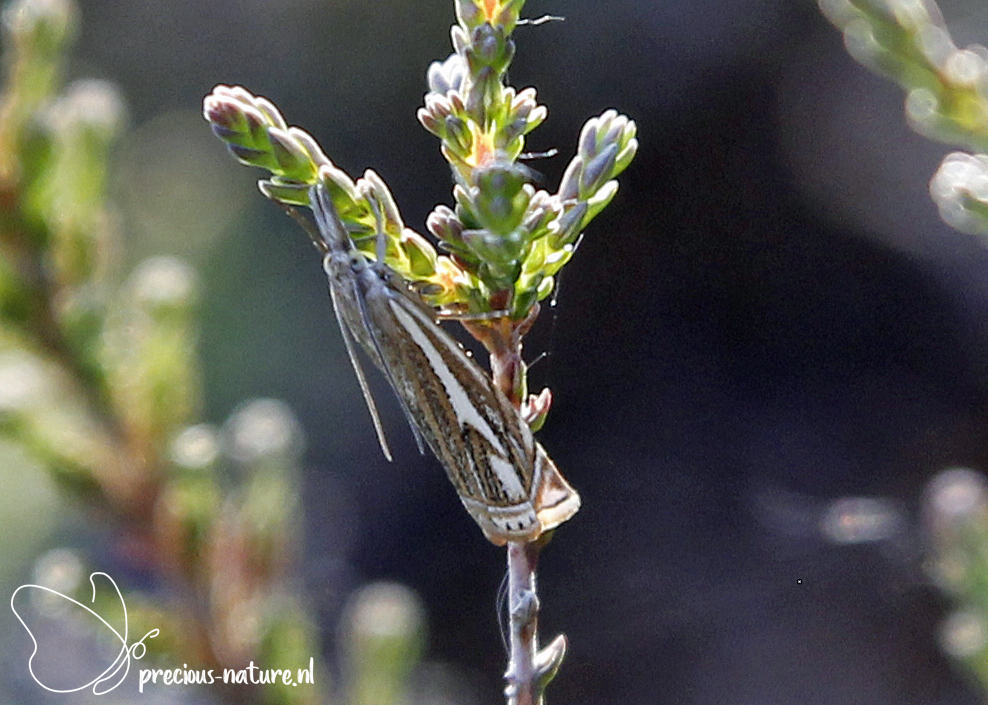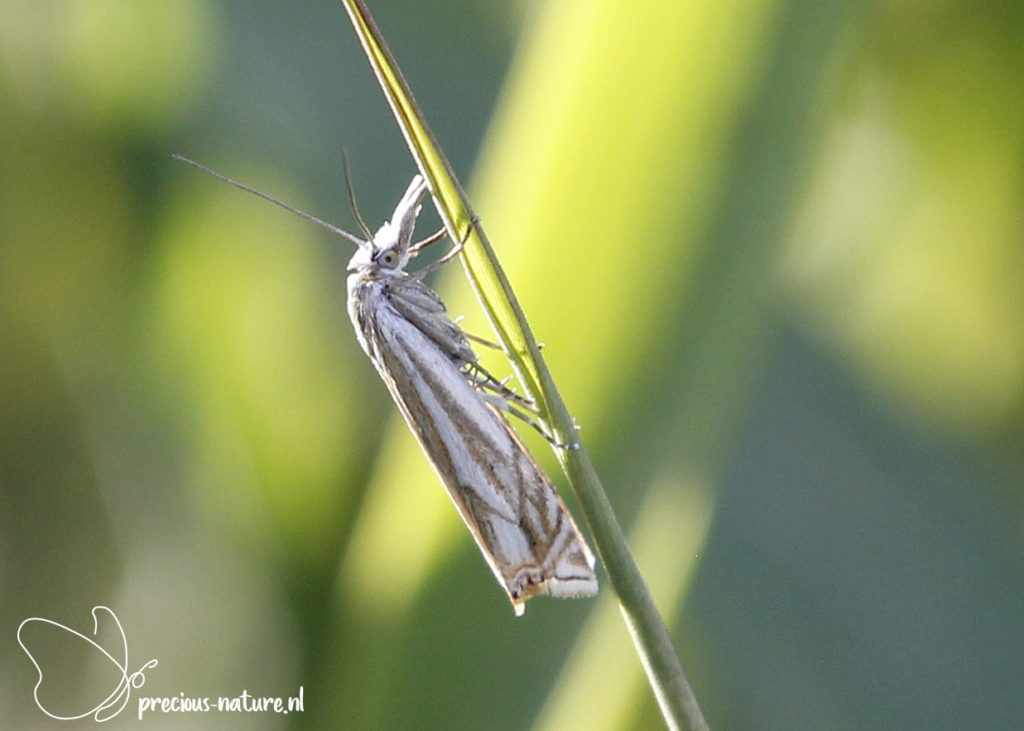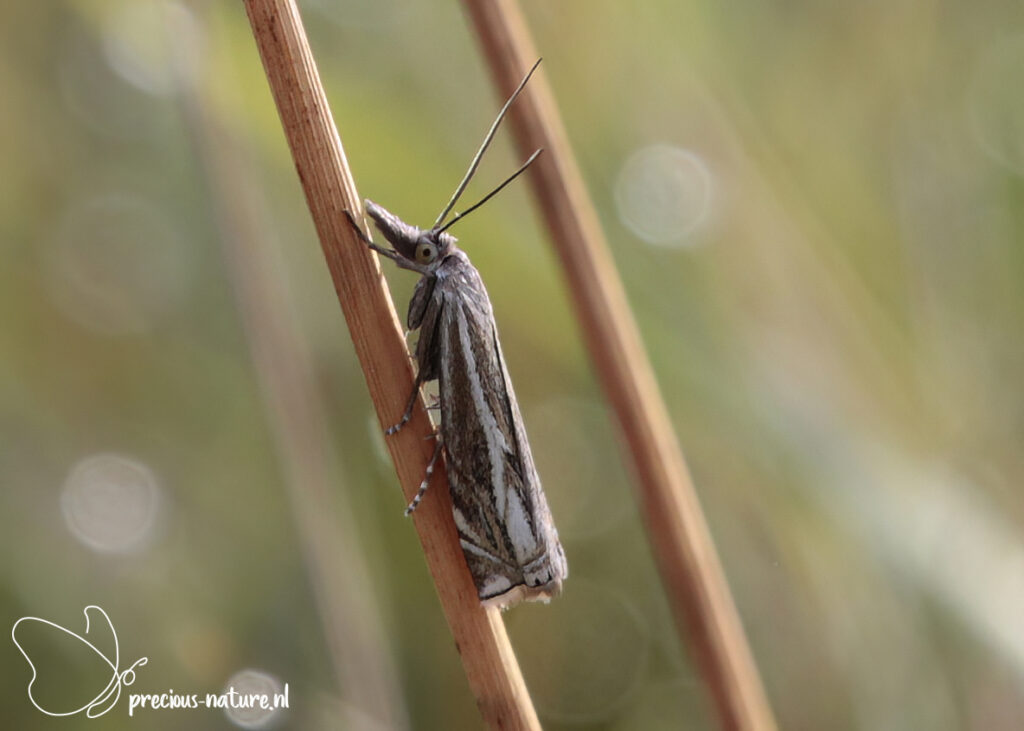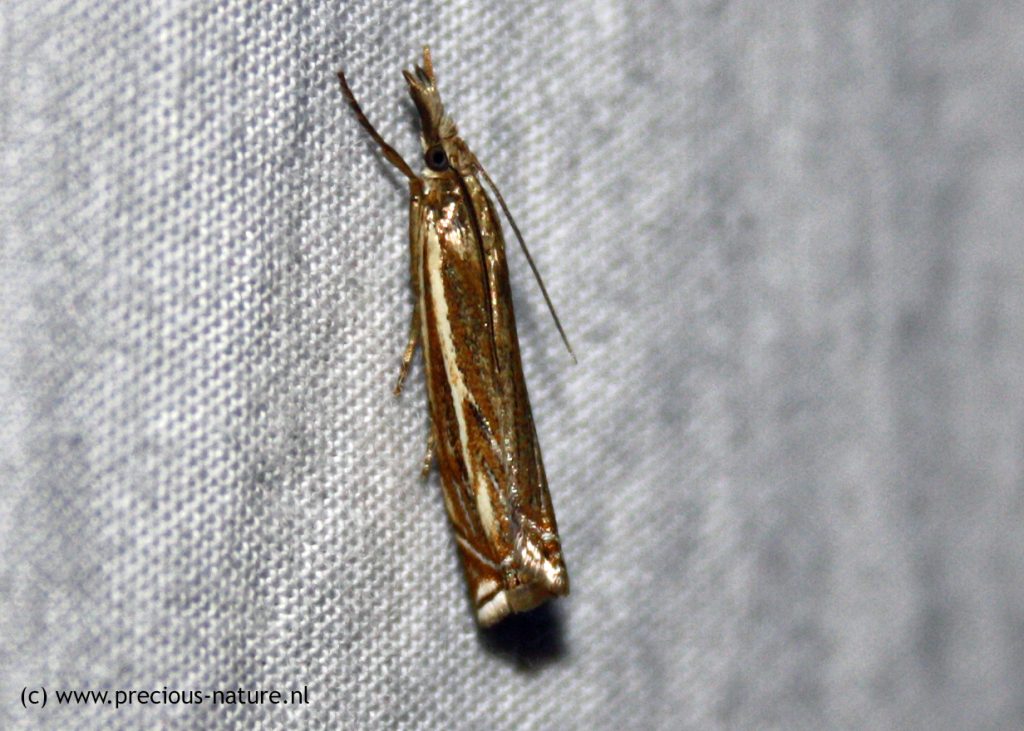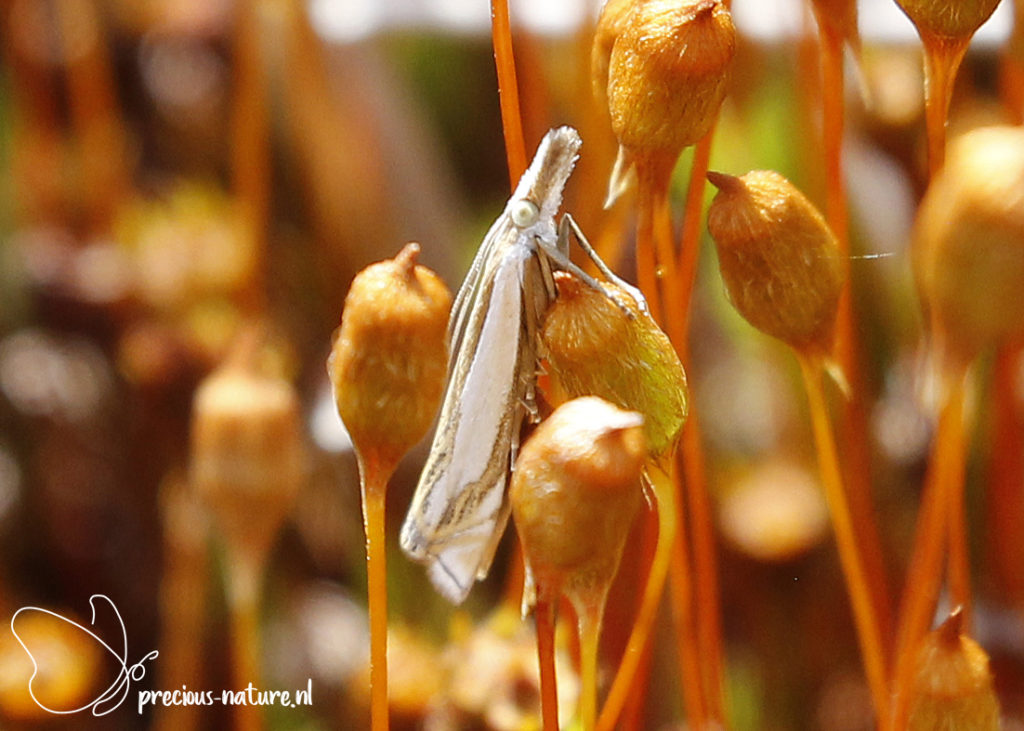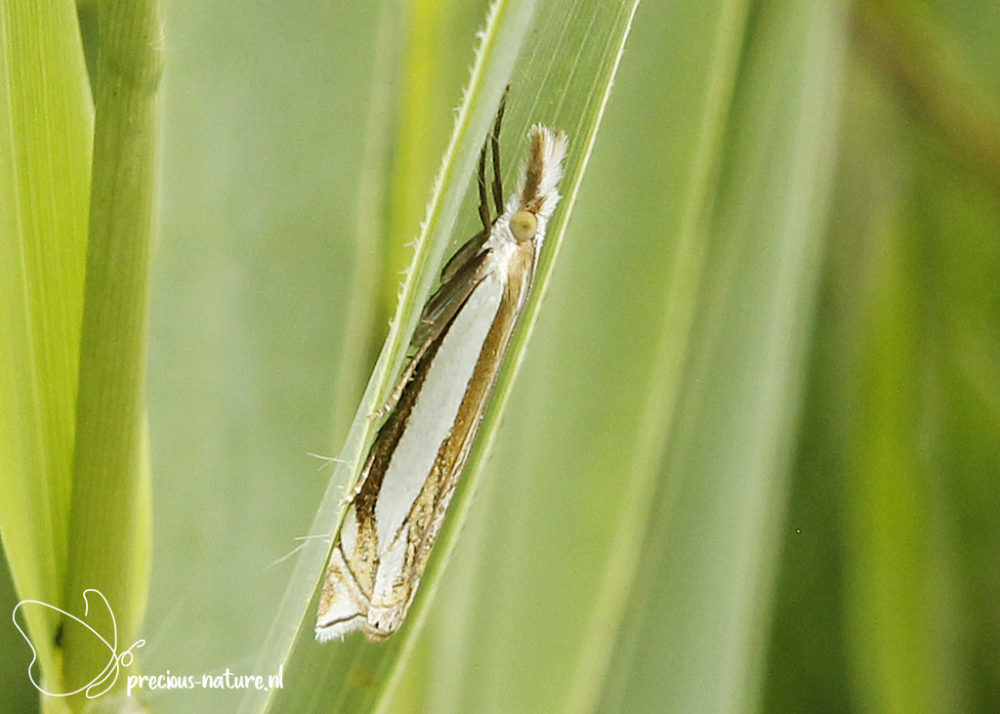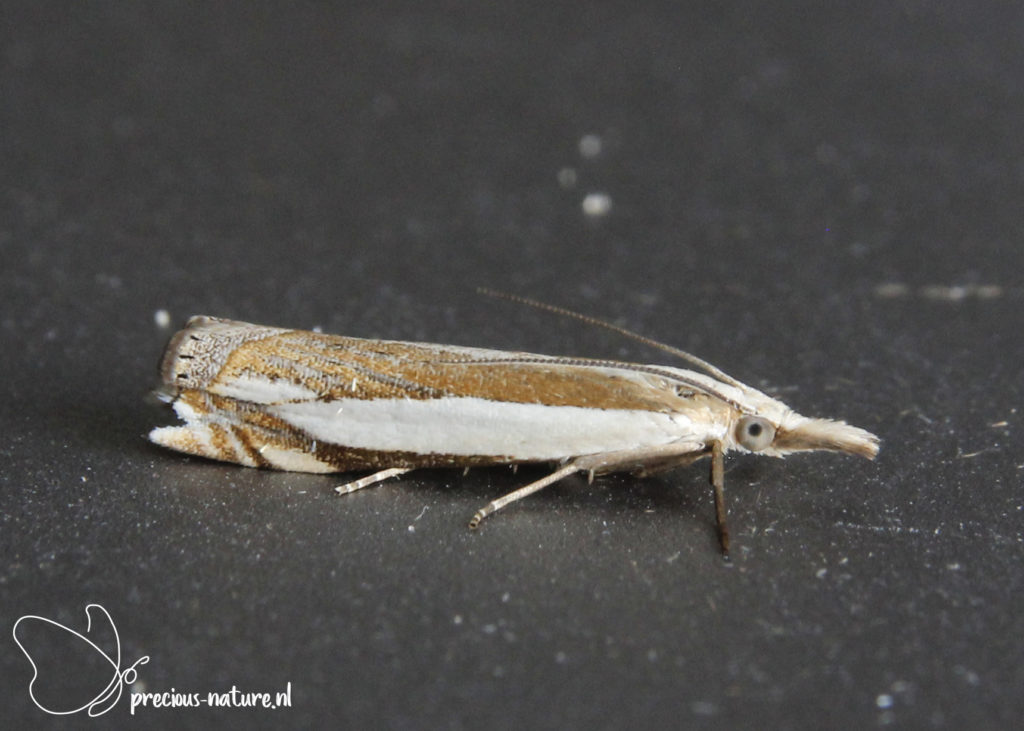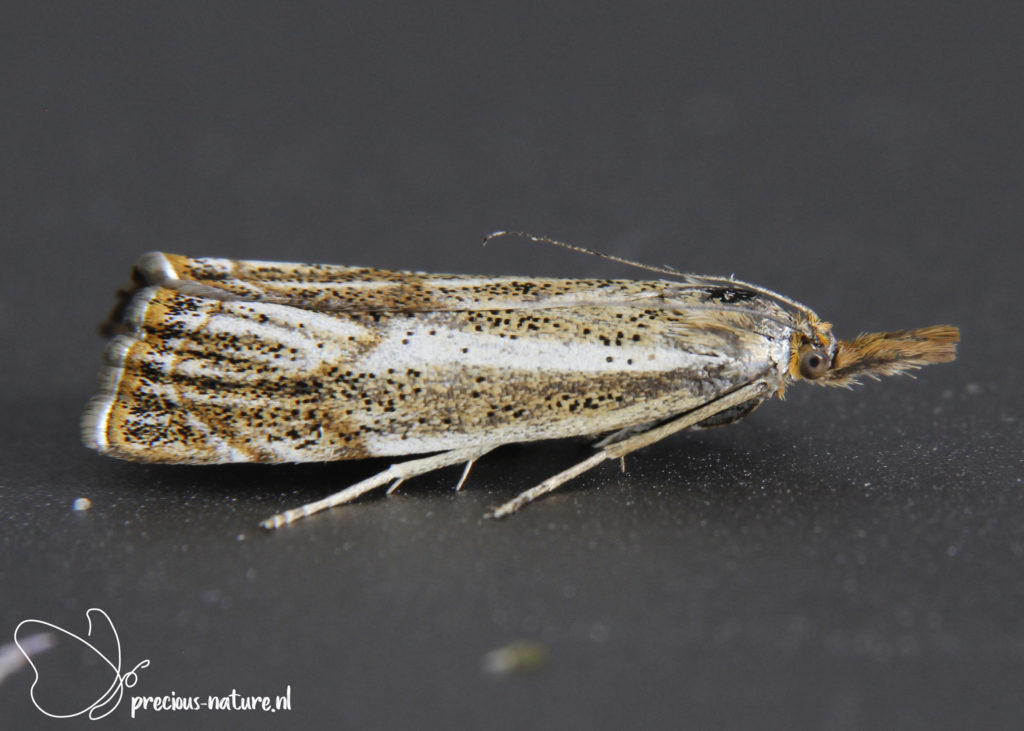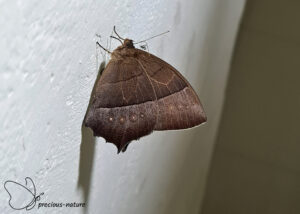Crambinae are a large subfamily of the Grass Moths (Crambidae) with about 1800 registered species worldwide. The larvae mainly feed on the roots or stems of grasses. Characteristic is the narrow forewing and the wide hindwing so that they appear much larger in flight than when they are in the resting position. During the day they are easily disturbed and quickly find another place. They then go with their heads towards the ground, wings folded around the body, as close to a grass stem as possible.
Genus: Agriphila
Straw Grass-veneer – 2015 (NL)
(NCBI-index: 572809)
The Straw Grass-veneer (Agriphila straminella) is notable for its usually light blue eyes. Sometimes the eyes are very dark. This may also be due to the flash during shooting. Furthermore, this grass moth is not spectacular in terms of color and marking. It is a pale light brown moth with no specific transverse lines. The flight time in one generation is from June to September and you often see them flying up from long grass to quickly find another hiding place. The wingspan is 16-19mm. The larvae feed on the lower part of the stems of various grasses. Host plant: grasses. Dutch name: Blauwooggrasmot. Frisian name: –
Flying period:

Genus: Agriphila
White-streak Grass-veneer – 2019 (NL)
(NCBI-index: 2.560927)
The White-streak Grass-veneer (Agriphila latistria) is notable in resting position because of the white stripe running the length of its wings. The rest of the forewing is brown-yellow. The hindwing is white. They are mainly active at night and are attracted to light. The flying period in one generation is from July to September and the wingspan is 22-27mm. The larvae feed on grass stems. Host plant: Brome. Dutch name: Witlijngrasmot. Frisian name: –
Flying period:

Genus: Agriphila
Pale-streak Grass-veneer – 2023 (NL)
(NCBI-index: 1.660580)
The forewing of the Pale-streak Grass-veneer (Agriphila selasella) is sandy yellow or yellow-brown. A white narrow band can be seen along the length of the wing, which divides into 3 or 4 branches that turn light brown near the inner edge. The similar Common Grass-veneer (Agriphilla tristella) has a narrower, yellow or cream-colored, but never white, longitudinal stripe across the wing. The flight period is in one generation from June to September and the wingspan is 22-30mm. Host plant: Common Salt-marsh Grass and Sheep’s Fescue. Dutch name: Smalle witlijngrasmot. Frisian name: –
Flying period:

Genus: Ancylolomia
Scarce-striped Grass-veneer – 2018 (FR)
(NCBI-index: –)
A special grass moth, mainly due to its size, is the Scarce-striped Grass-veneer (Ancylolomia tentaculella). This grass moth is oversized compared to the species that you encounter in the Netherlands. You do not come across this species in the Netherlands, but you will find it in Southern and Central European countries. I translated the name from the English name which, unlike the Dutch, can be found on the web. From the base of the wing, a white or cream-colored longitudinal stripe can be seen on the front wing, which deflects slightly close to the rear edge. The white stripe is bordered by a black stripe that becomes less intense towards the termen. Near the termen, a slightly wavy brown thin transverse band can be seen with a grey-colored wavy line right next to it. Between these two wavy lines and the back edge, which shows a thin dark line, is a row of dark dots. The flying period is from June to August and the wingspan is 30-34mm. Host plant: Various larger grasses. Dutch name: Schaars gestreepte grasmot. Frisian name: –
Flying period:

Genus: Calamotropha
Bulrush Veneer – 2017 (NL)
(NCBI-index: 1.371681)
Both males and females of the Bulrush Veneer (Calamotropha paludella) have a bright white hindwing. The males are slightly smaller and darker in color. The forewing is pale brown with a dot in the center. The length of the veins of the wing is visible and darker than the base color of the wing. The flying period in one generation is from July to September and the wingspan is 22-33mm. The slender larvae bore into the leaves, stems, and the upper part of the rootstock. Host plant: Bulrush, and Lesser Bulrush. Dutch name: Lisdoddesnuitmot. Frisian name: –
Flying period:

Genus: Catoptria
Pearl-band Grass-veneer – 2018 (NL)
(NCBI-index: 1.869554)
The first time I saw the Pearl-band Grass-veneer (Catoptria margaritella) was also the last time for this specimen. He became breakfast for another bug. The forewing of this grass moth is light brown to reddish-brown. A broad white stripe runs down the length of the wing bends at 4/5 towards the tip of the wing and ends just before the costa. The hindwing is grey with a white wing edge. The flying period is from the end of June to September in one generation and the wingspan is 20-23mm. The larvae are located in a small silk tube. Host plant: Mosses. Dutch name: Gelijnde vlakjesmot. Frisian name: –
Flying period:

Genus: Catoptria
Chequered Grass-veneer – 2018 (NL)
(NCBI-index: 1.100936)
The fairly recognizable Chequered Grass-veneer (Catoptria falsella) has a pale straw yellow forewing. The wing has clear veins with intense speckling between them. In the longitudinal direction, there is a wide white stripe that narrows 2/3 along a transverse line. Then the stripe changes into three separate “teeth” towards the termen. The flying period is from June to September in one generation and the wingspan is 18-22mm. The larvae feed on a silk tube deep in the moss. Host plant: Mosses. Dutch name: Drietandvlakjesmot. Frisian name: –
Flying period:

Genus: Catoptria
Marbled Grass-veneer – 2019 (NL)
(NCBI-index: 1.594246)
I am more and more alert to micro-moths and notice that I see more and more new species. It is often difficult to get a good picture of them. One such new species is the Marbled Grass-veneer (Catoptria verellus). It is sometimes confused with the Chequered Grass-veneer (Catoptria falsella) but is still quite easy to distinguish. Both have multiple brown, black, and white elongated paces, but the Marbled Grass-veneer does not have a large white pace from the base of the wing to about 2/3 of the wing. The fringes are black and white checkered. The flying period is from May to September in one generation and the wingspan is 17-18mm. Host plant: Mosses. Dutch name: Zwartbruine vlakjesmot. Frisian name: –
Flying period:

Genus: Catoptria
Pearl Grass-veneer – 2020 (NL)
(NCBI-index: 1.100938)
The forewing of the Pearl Grass-veneer (Catoptria pinella) is golden brown with a wide white band in the longitudinal direction of the wing that is split in two by a dark brown narrow band. There is another dark brown band between the white band and the termen. The difference with the similar Scotch Grass-veneer (Catoptria permutatellus) is the missing narrow white transverse band that runs from the dorsum into the marginal area. The flying period in one generation is from June to September and the wingspan is 18-24mm. The larvae feed in a silken tube. Host plant: Tufted Hair-grass, Cottongrass, and sedges. Dutch name: Egale vlakjesmot. Frisian name: –
Flying period:

Genus: Chrysoteuchia
Garden Grass-veneer – 2009 (NL)
(NCBI-index: 1.594250)
The Garden Grass-veneer (Chrysoteuchia culmella) is one of the most common grass moths. It can be easily recognized by its one or two curved transverse lines and the golden white wing edge of the forewing. The ground color of the wing is light yellow with a pattern of brown lines. There are also examples where the pattern of brown lines is not present. The Garden Grass-veneer flies in one generation mainly at night from June to August and rests on blades of grass with its head down during the day. The wingspan is 20mm. The larvae feed on the stems of different types of grasses. Host plant: Various grasses. Dutch name: Gewone grasmot. Frisian name: –
Flying period:

Genus: Crambus
Satin Grass-veneer – 2015 (NL)
(NCBI-index: 687067)
The Satin Grass-veneer (Crambus perlella) comes in 2 forms. The most common variety is creamy white with a silky sheen. The other species has a brown ground color with a distinct white longitudinal band. The flight time in one generation is from July to September and the wingspan is 21-28mm. The larvae feed in a silk tube close to the base of the stems. Host plant: Various grasses. Dutch name: Bleke grasmot. Frisian name: –
Flying period:

Genus: Crambus
Hook-streak Grass-veneer – 2017 (NL)
(NCBI-index: 1.100958)
The Hook-streak Grass-veneer (Crambus lathoniellus) is a brownish-yellow moth with white stripes on the forewing. These white stripes are thinner than on other related species and the males are darker than the females. The Hook-streak Grass-veneer is one of the first moths of its related species to fly around. The flight time in one generation is from May to September and the wingspan is 20mm. The larvae feed on the base of the stem. Host plant: Various grasses. Dutch name: Vroege grasmot. Frisian name: –
Flying period:

Genus: Crambus
Scarce Grass-veneer – 2018 (NL)
(NCBI-index: 1.594261)
A fairly common grass moth is the Scarce Grass-veneer (Crambus pratella). The forewing is light reddish-brown. A white stripe can be seen across the wing that widens from the base. At 2/3, this white stripe is interrupted by an oblique line from which a small white spot bends obliquely followed by two thin oblique white stripes. Near the apex, two white stripes run diagonally toward each other. The fringes on the termen are white metallic. The flying period in one generation is from June to early September and the wingspan is 22-25mm. The larvae feed on the roots and stems of various grasses. Host plant: Various types of grass. Dutch name: Streepjesgrasmot. Frisian name: –
Flying period:

Genus: Crambus
Inlaid Grass-veneer – 2018 (NL)
(NCBI-index: 989760)
The Inlaid Grass-veneer (Crambus pascuella) has a broad white stripe on an otherwise brown wing that runs from the base to 4/5 in the direction of the apex. Just beyond that large white stripe is a smaller second white stripe. There is a white triangle on the apex and a clear angled white transverse line surrounded by a slightly dark brown line. The flying period is from May to August in one generation and the wingspan is 21-26mm. The larvae can be found in a silk tube at the base of the stem. Host plant: Grasses. Dutch name: Zilverstreepgrasmot. Frisian name: –
Flying period:

Genus: Thisanotia
Powdered Grass-veneer – 2021 (NL)
(NCBI-index: 1.870370)
The forewing of the Powdered Grass-veneer (Thisanotia chrysonuchella) is whitish, finely speckled black, with a tinge of brown in a broad streak along the costa. Furthermore, two narrower longitudinal bands run to the inner edge, with an oblique, slightly bent brown transverse line at a little more than half that merges into the bands of the brown shade. A thinner brown cross line at about five-sixths curves towards the leading edge and the fringe is metallic. The flight period is from April to July in one generation and the wingspan is about 24mm. Host plant: Sheep’s-fescue. English name: Powdered Grass veneer. Frisian name: –
Flying period:


